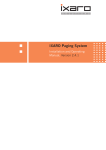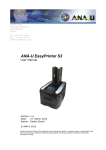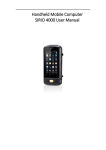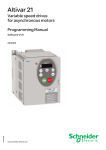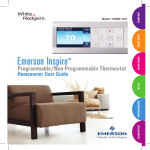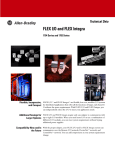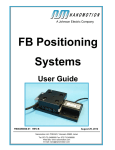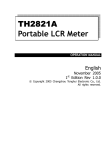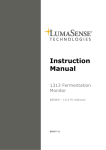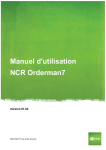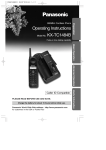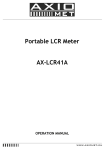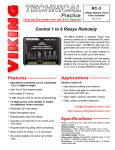Download ,QWHJUD - systemhuset
Transcript
System description Integra V5 -integrated security ,QWHJUD The Home of Bravida Integra System description Bravida Integra V5 1 2 3 4 5 6 7 8 9 General information on Bravida Integra................................................................ 2 System components ............................................................................................ 2 Keycards .............................................................................................................. 7 Communication between PC/server and C-Node ................................................. 9 Software, platforms and functions ...................................................................... 13 System security ................................................................................................. 15 Alarm collection, presentation and management ................................................ 16 Special functions ................................................................................................ 17 Interfaces with other systems ............................................................................. 18 Bravida Säkerhet AB Systemhuset EN_Systembeskrivning Bravida Integra F123 inlaga v4 Uppdaterad 20120413_cs_3.docx2 2012-04-13 System Description Bravida Integra V5 1 General information on Bravida Integra Access control and alarm systems are essential for the implementation of security within commerce and industry and public spaces. Getting the best possible security at the best price is equally important as a fully functioning system with the best possible functionality. Bravida Integra is an integrated security system for access control, card production, burglary alarms, fire alarms, and CCTV surveillance that provides excellent security at a reasonable price. Bravida Integra is simple to manage, and it is fully possible to expand the system with additional customised functions. Bravida Integra is simple to integrate and manage external systems through additional modules, OPC, Data Service and Alarm Service. Bravida Integra has been developed to satisfy the market's stringent demands for functionality and ease of use. This system description is intended to provide an overview of the system's components, as well as demonstrate the options and solutions that Bravida Integra has to offer. For more detailed information, please refer to the user manual, consultant manual and the individual product sheets. Please also visit our website at www.systemhuset.com or www.bravidasakerhet.se 2 System components 2.1 Software Bravida Integra – a scalable system The software for Bravida Integra is scalable, can be modified and is capable of handling both large and small systems. The largest installations comprise thousands of door environments and alarm points, while the smallest systems may only have a few. Item 44283005 2.1.1 Bravida Integra Base For smaller systems that require a high level of security and userfriendliness, but have fewer door environments and alarm points. Item 44283010 2.1.2 Bravida Integra Premium For medium-sized to large systems or when you want to integrate other products via one of the many interfaces supported by Bravida Integra. Well-planned and easy-to-use alarm graphics can be used to visualise and manage alarm points. There is the option of connecting one or more control panels for alarm presentation and management of alarm zones. Page 2(20) System Description Bravida Integra V5 Item 44283020 2.1.3 Bravida Integra Enterprise For large systems that demand high performance and functionality. Well-planned and easy-to-use alarm graphics can be used to visualise and manage alarm points. There is the option of connecting one or more control panels for alarm presentation and management of alarm zones. Enterprise is able to handle a large number of door environments and operators. The above system sizes can be supplemented with a number of additional modules, such as CCTV, Data Service, Guard Report, Alarm Distribution, Alarm Monitoring, etc. More information on these modules can be found in the separate product sheet 'Additional functions'. Bravida Integra comprises this program: 2.1.4 Bravida Integra Server Bravida Integra Server handles communication between PCs and substations. The program launches automatically with Windows as the operating system. 2.1.5 Bravida Integra Client Bravida Integra Client can be run on the same computers as the server software. The licence for the Client program can be used by several computers, but only one user can use the program per licence. Both the Premium and Base versions can be expanded with several licences. 2.1.6 Bravida Integra Card Production Bravida Integra Card Production Client is an additional module that enables card production. Card production is fully integrated and the program includes the taking of photos, printing and designing the end card. The card printer can code magnetic strips and proximity cards in connection with the printing of keycards. 2.1.7 Bravida Integra DS EasyConnect Bravida Integra DS EasyConnect is a program that acts as a link from external system for ex HR system into Bravida Integra Server. DS communicate with 3rd party systems using SOAP protocol and webservice interface. DS has following features: Cardholder: Create, Update, Read, Delete Card: Create, Update, Read, Delete, Attach to CH and Detach from CH Access level: Get list of AL in BI, Attach to CH and Detach from CH 2.1.8 Bravida Integra OPC Server Bravida Integra OPC Server is a program that acts as a link from Bravida Integra Server into external system. Bravida Integra OPC server allows for example to external systems tot: -Open doors -Controlling areas -Controlling the alarm relays -Reading status as alarm points. OPC is an open standard for integration of systems. OPC (OLE for process control) is a standard specified by the OPC foundation for communication between computers. Page 3(20) System Description Bravida Integra V5 2.1.9 Bravida Integra OPC Client Bravida Integra OPC Client is a program that acts as a link from external system into Bravida Integra Server. The OPC Client converts OPC Tags into points that can be shown inside Bravida Integra Client as standard objects. There are two kinds of objects which can be created inside Bravida Integra Client, inputs (External Digital Input) and outputs (External Digital Output). 2.1.10 Bravida Integra Alarm Service Bravida Integra Alarm Service is a program that acts as a link from external system into Bravida Integra Server ex Pagingsystem as Ascom, Posag and more systems 2.2 Substations 2.2.1 Substation C-Node C-nodeG2 can handle up to 30 nodes for door environments and alarms or 30 wireless readers. The node has an internal memory and a database that handles local cards, access rights, time zones, security levels, and other integral functions in the system. Information is always retrieved from the internal database. This means that all principal information and functionality is available even in offline mode. In C-nodeG2 it is implemented a memory management which allows you to splitt database and makes it possible for storing a huge number of access cards, 450 00 Cards have been tested. C-nodeG2 can communicate with a host system on TCP/IP , RS232 or a dial-up modem. 2.3 Power supply with battery (UPS) C-nodes and underlying units are supplied with power from a separate direct current with connected battery pack comprising 2 x 40 AH batteries or larger, if so required. This provides sufficient power for several hours' use in the event of loss of power. 2.4 Door nodes and alarm nodes Various nodes for door controls and alarms are connected to substations. 2.4.1 S-Node S-node is a door alarm system suitable for high-security doors. It can also be used purely as an I/O unit that stores alarms and performs any action required. When the S-node is used as a door node, eight inputs and eight outputs are available. Page 4(20) System Description Bravida Integra V5 When the S-node is used as an alarm node, eight inputs and two outputs are available. S-node communicates with a host C-node on LON-bus FTT-10. S-node is sabotage-proof. S-node is supplied with 24 VDC and has an output with a 12 VDC supply for alarm detectors. The output can be loaded up to 1A. All inputs on the S-node can be defined as digital or doublebalanced. 2.4.2 ComHub ComHub- is a doorbox for 1:1 or 1:8 wireless readers BCR-SW. The ComHub communicates with a host C-node on RS485. ComHub is supplied with 24 VDC. 2.5 Card readers Bravida Integra includes a number of different card reader models (BCR) that support magnetic cards and proximity keycards, such as EM-marine and Mifare. All other card models that support Wiegand – or 'data-clock' interfaces can be used, including various types of biometric system. 2.5.1 BCR-SD and BCR-S mini Proximity readers for Mifare BCR-SD 1.5 Black BCR-SD: A BCR-SD Card Reader is included in the Bravida Integra access system for contactless card reading.The BCR-SD has a keypad for usage in door environments that require an access code. The card reader is equipped with a with built-in antenna for card reading, a clearly visual keypad, LED indications, internal buzzer and convenient display for graphical symbols.The card reader is sabotage protected in a sturdy ABS case, with EIA485 interface. BCR-S mini: A BCR-S Mini Card Reader is included in the Bravida Integra access system for contactless card reading. This card reader has a sturdy design.The card reader is complete with built-in antenna for card reading, LED indications, internal buzzer and EIA485 interface. With moulded plastic encapsulation. BCR-S mini BCR-SD and BCR-S mini handle Mifare Classic: UID, sector reading and MAD with 4 or 7 byte a and Mifare Plus: UID, sector reading and MAD SL 0-3 with 4 or 7 byte in the same readers and time. The card readers is generally mounted in a door environment with the door control unit S-Node in a part assembly. The lightweight format is easy to place for ultimate user convenience. NXP Semiconductor has developed the smart card technology Mifare. Mifare is based on RFID technology that is currently used in fields such as transport, payment services, security, and many Page 5(20) System Description Bravida Integra V5 others. The technology is useful in that it is possible to save data in several sectors on the card. Reading can employ a serial number, a sector and MAD2. Card readers with Mifare technology read the card at a distance of up to 5 cm from the reader (CR80 Cards). The read distance varies depending on the surroundings and any radio or metallic interference. The cards for Mifare and Prox readers can be supplied as traditional cards or keyrings. Credit card-size proximity cards(CR80) can be combined with a magnetic strip and printed using a normal card printer. 2.5.2 BCR-SW wireless Proximity readers for Mifare BCR-SW is the smart technology that enables mechanical locks to be wirelessly linked to Bravida Integra access control system. The heart of BCR-SW is a short-distance, wireless communication protocol, designed to link with an online electronic access system with an BCR-SW enabled mechanical lock. BCR-SW E100 S A straightforward, easy and convenient way to add more doors to a security system that can be monitored, BCR-SW allows for online access control and management, increasing both security and controllability. BCR-SW handle Mifare Classic: UID or sector reading otherwise Mifare Plus: UID or sector reading. 2.5.3 BCR-PD and BCR-P mini Proximity readers for Prox EM-marine BCR-PD BCR-P mini BCR-PD: A BCR-PD Card Reader is included in the Bravida Integra access system for contactless card reading.The BCR-SD has a keypad for usage in door environments that require an access code. The card reader is equipped with a with built-in antenna for card reading, a clearly visual keypad, LED indications, internal buzzer and convenient display for graphical symbols.The card reader is sabotage protected in a sturdy ABS case, with EIA485 interface. BCR-P mini: A BCR-P Mini Card Reader is included in the Bravida Integra access system for contactless card reading. This card reader has a sturdy design.The card reader is complete with built-in antenna for card reading, LED indications, internal buzzer and EIA485 interface. With moulded plastic encapsulation. BCR-PD and BCR-SP mini handle EM Marin: 4200 RO and 4550 RW in the same readers and time. The card readers is generally mounted in a door environment with the door control unit S-Node in a part assembly. The lightweight format is easy to place for ultimate user convenience. Page 6(20) System Description Bravida Integra V5 EM Microelectronic-Marin SA is a company in the Swatch Group that supplies chip technology suitable for access control. This technology has become an industry standard and is used by numerous card and reader suppliers. Card readers with EM-marine technology read the card at a distance of up to 12 cm from the reader. The read distance varies depending on the surroundings and any radio interference. Otherwise, the reader has the same properties as a magnetic card reader. The cards for Mifare and Prox readers can be supplied as traditional cards or keyrings. Credit card-size proximity cards can be combined with a magnetic strip and printed using a normal card printer. - BCR-MPD, - BCR-MSD, 2.5.4 BCR-MSD and MSP Combination readers Combi-readers with a display are available in the combination: EM-marine/Magnetic Mifare/Magnetic Combi-readers are the same design as a magnetic card reader. 3 Keycards 3.1 Proximity cards, tags and Smart Cards (RFID) This technology is based on radio signals. The card contains an integrated circuit that draws current from a coil in the card when the card is moved close to the reader. The card therefore has no battery and will continue to work provided there is no physical damage to the card or tag. Credit card-size cards are available. These can also be combined with a magnetic strip or Smart Card chip. Keyring tags of various designs are also available. However, tags do have a slightly shorter read distance. Bravida Integra No1 on Smart Card: With Bravida Integra V5 a lot of effort has gone into developing a simple administrative solution for smart cards. Encryption keys for Mifare sector reading and MAD can be loaded from a central location using encrypted communication and without any separate programming of card readers being required. Bravida Integra V5 supports several encryption keys in the same card reader for Mifare sectors and MAD reading, which means that, in addition to the customer's unique keys, the same system can also read cards from several suppliers, e.g. SITHS (county councils), ID06, etc. Bravida Integra V5 supports EM Marin: 4200 RO and 4550 RW Mifare Classic: UID, sector reading and MAD with 4 or 7 byte Mifare Plus: UID, sector reading and MAD SL 0-3 with 4 or 7 byte Mifare DesFire EV1: UID Page 7(20) System Description Bravida Integra V5 Mifare Classic description: Mifare Classic can be used with ISO/IEC 14443-A unique serial number, 4 or 7 byte and random IDs. The security level uses CRYPTO1 encryption based on a 48 bit key length. Mifare Plus description: Mifare Plus can be used with ISO/IEC 14443-A unique serial number, 4 or 7 byte and random IDs. Mifare Plus cards can be operated in multiple security levels. The highest security level uses AES (Advanced Encryption Standard) encryption based on a 128-bit key length. Lowest security level uses Crypto1. In order to make migration process for existing infrastructures based on MIFARE Classic easier, the MIFARE Plus chip on its lowest security level will be backwards compatible with MIFARE Classic. Cards using chips in this lowest security level can be switched to a higher security level. Once card is switched it can only operate in that higher security level and cannot be switched back to a lower security level. • Security Level 0 - MIFARE Plus cards are pre-personalized with configuration keys, level switching keys, MIFARE Classic CRYPTO1 and AES keys for the memory. • Security Level 1 - In this level the cards are 100% functionally backwards compatible with MIFARE Classic 1K / 4K cards. Cards work seamlessly in existing MIFARE Classic infrastructure. • Security Level 2 - Mandatory AES authentication. MIFARE Classic CRYPTO1 for data confidentiality. • Security Level 3 - Mandatory AES for authentication, communication confidentiality and integrity. Optional proximity detection (MIFARE Plus X only). EM Marin Prox 125 kHz: The EM4450 is a CMOS integrated circuit intented for use in electronic Read/Write RF Transponders. The chip contains 1 KBit of EEPROM which can be configured by the user, allowing a write inhibited area, a read protected area, and a read area output continuously at power on. The memory can be secured by using the 32 bit password for all write and read protected operations. The password can be updated, but never read. The fixed code serial number and device identification are laser programmed making every chip unique. The EM4450 will transmit data to the transceiver by modulating the amplitude of the electromagnetic field, and receive data and commands in a similar way. Simple commands will enable to write EEPROM, to update the password, to read a specific memory area, and to reset the logic. Page 8(20) System Description Bravida Integra V5 The coil of the tuned circuit is the only external component required, all remaining functions are integrated in the chip EM4200 is a CMOS integrated circuit intended for use in electronic Read Only RF transponders. It is designed to replace directly the EM Microelectronic-Marin Read Only ICs EM4100/4102 and EM4005/4105. Comparing to EM4100/4102 and EM4005/4105, the chip provides higher reading range performances and presents on its coil terminals bigger resonant capacitor (210pF and 250pF selectable by mask option). The 128 bit unique code is stored in laser programmed ROM. Several options are available to use 64, 96 or 128 bits of ROM. The circuit is powered by an external coil placed in an electromagnetic field and gets its master clock from the same field. By turning on and off the modulation current, the chip will send back the unique code contained in a factory preprogrammed laser ROM. 4 Communication between PC/server and C-Node The Bravida Integra concept offers several different means of communication between server and subordinate C-nodes. This provides good flexibility for administration involving several units. 4.1 Communication via RS-232 All C-nodes have built-in communication ports for RS-232. RS232 ports can be used for, among other things, upgrades or other technical procedures. RS-232 communication can also be used for normal updating of substations, although this is limited to just 1 or 2 substations. 4.2 Communication via Ethernet/IP VPN TCP/IP communication over a network is the best option when communication involves units at multiple geographic locations. The C-node is equipped with a network card for communication over Ethernet via TCP/IP protocols. The substation can then be connected to the PC network while it is online. C-node must be fitted with network cards if Ethernet is to be used. A fixed IP address is defined for C-node. Page 9(20) System Description Bravida Integra V5 4.3 Communication using a dial-up modem It is also possible to communicate with C-nodes over an analog or digital (ISDN) dial-up modem. A modem is connected to the RS232 port on the C-node. One or more analog modems that dial up the C-node when data needs to be transferred are connected to the central control unit. The C-node can also dial up the central unit if an alarm or other data needs to be reported. Communication using a dial-up modem requires a telephone socket and a suitable analog or digital modem. 4.4 Communication using GSM GSM It is possible to communicate with C-nodes using GSM technology. This method requires the C-node to have a GSM module, as well as a GSM subscription for data traffic. One or more modems that dial up the GSM module in the C-node when data needs to be transferred are connected to the central control unit. The C-node can also dial up the central unit to report alarms or other data. GSM communication is useful when other communication solutions are unfeasible. Page 10(20) System Description Bravida Integra V5 4.5 System design Page 11(20) System Description Bravida Integra V5 LON 4.5.1 Communication via LON (Echelon FTT-10) LON bus communication is used for communication between Cnod and Sub node (S-nod). This method is intended for situations where there are multiple substations within a relatively small area. The cable distances without using repeaters are comparatively long and the cabling is easy to lay. Network cards are not necessary. C-node has a built-in communication port for LON communication to Sub node. 4.5.2 Communication Wifi RS485 bus communication is used for communication between C-nod and RadioHub for Wifi readers, the cable distances without using repeaters are comparatively long and the cabling is easy to lay. C-node has a two built-in communication port for RS485 communication. Wifi communication between RadioHub and BCR-SW readers is at IEEE 802.15.4 define the Medium Access Control and the Physical layer for WSN. It operates primarily in the 2.4 GHz ISM band, using 16 channels. The bandwidth of each channel is 5MHz. The MAC employs the Carrier Sense Multiple Access with Collision Avoidance (CSMA/CA) mechanism. Clear Channel Assessment (CCA) is used in the physical layer to determine the channel occupancy Page 12(20) System Description Bravida Integra V5 5 5.1 Software, platforms and functions Operating systems and programming language The system employs a standard PC platform and is compatible with Windows XP, Windows Vista, Windows 7 and Microsoft Server 2005 and 2008, 32 or 64 bits R2 . The Bravida Integra program is written using Microsoft Visual C++. 5.2 Database The system uses SQL Server as a database. The actual database is normally MS SQL 2008 Express. The full version of SQL Server can also be used. The database is run as a background program to Integra Server PC Bravida Integra is compatible with MS SQL 2005 and 2008 64 bit R2. 5.3 Screen management Administrative work is performed in an environment similar to Windows Explorer. The structure comprises folders and objects in the same way as Explorer. Objects represent all individuals, components and parameters present in the system. Folders with subfolders are created individually as required. The system uses the 'drag-and-drop' principle to move between folders and to link objects. One example would be access permission for individuals. Page 13(20) System Description Bravida Integra V5 5.4 Access levels The access permissions in the system are based on a combination of card readers. Each card reader can be linked to a time zone for when a card with specific rights can be used. Access permission can also be linked to access for using 'bistable opening', where a card reader is used to set a door to permanent open mode. 5.5 Time zones Time zones are found in 'Day schedule for time zones' and 'Time zone'. In addition, the system also has an 'Analog time zone'. 5.5.1 Day schedule for time zones The day schedule defines periods within each 24 hours when a time zone will be on and off. One-minute intervals are used. The period is defined using the left and right mouse buttons for on and off respectively, and can be highlighted using the mouse cursor to change periods within the 24-hour period. The day schedule follows the predefined time period. 5.5.2 Time zone (comprising day schedule) Time zones are used for normal time-controlled functions, such as restricted access to doors. A time zone is made up of several day time zones. A day time zone can last several days for a single activity. This is determined in the field used to select the 'day' period. The periods that can be selected are: Date Special days Monday-Friday Monday-Thursday Saturday-Sunday Holidays A time zone is normally made up of Monday-Friday, SaturdaySunday, and a holiday. 5.5.3 Calendar The calendar function is used to specify the function of a time zone on an unspecified holiday. 5.5.4 Analog time zone An analog time zone is used to limit functions by time, for instance, open doors with a time limit (e.g. 30 min) or 'buy time' when bypassing burglary alarms. Page 14(20) System Description Bravida Integra V5 5.6 Security levels The security level determines how the various card readers will function during the day. 5.6.1 Security level A security level is created in the same way as a time zone, but uses a day schedule for the security level. A security level can be used by one or more card readers. 5.6.2 Day schedule for security level A day schedule for a security level determines how a card reader will function during the day. The options are for ex: Unlocked: Card: Locked: Card+PIN Bistable card Bist. card+PIN GIN Usually a main entrance during normal working hours Usually a department door during normal working hours Usually a back door during evenings Normally all doors with a keypad during evenings/at night Usually an office door that is opened/closed regularly As above but with PIN code Group code 6 System security 6.1 Communication LAN/WAN LON FTT-10 6.2 Database 6.1.1 Between server and substations Communication between servers and substations is possible over different communication interfaces. Regardless of the type of communication, data can be encrypted, which increases security. 6.1.2 Between substation and door environment Communication between substations and door environments/nodes is via LON in FTT-10. This type of communication can also be encrypted. The encryptions of the communication between the host and card reader is AES128 and if using Mifare Plus SL3 then even AES128 encryption between the card and card reader. Microsoft SQL Server is used as the system database. MS-SQL has the necessary security systems already built in. For more detailed information, please refer to the document: C2 Administrator's and User's Security Guide. Page 15(20) System Description Bravida Integra V5 6.3 Password procedures Bravida Integra requires users to have their own password, which is chosen by the user. 6.3.1 Operator User access will be defined for each user: • How long the user will remain logged in • The time or date for which permission applies • Rules on how long a password remains valid • Number of characters in the password (1-15) • Rules for automatic blocking There is no limit to the number of users that can be defined. All passwords are encrypted and stored in the database. 6.3.2 User groups Each user is assigned to a user group. The various user groups receive different access rights to folders in the system. Access to folders is configured for functions such as display, change, delete, etc. There is no limit to the number of groups that can be configured. 7 Alarm collection, presentation and management 7.1 Collecting alarms 7.1.1 Alarm inputs on S-node S-node can be used as a combined door and I/O node or solely as an I/O node. When used solely as an I/O node, it has 8 doublebalanced alarm inputs and 4 relay outputs. 7.2 Acknowledging alarms in an alarm list An alarm list of unacknowledged alarms can be shown on the screen. Various colours are used to indicate status. Active alarms appear red. Active acknowledged alarms appear green, etc. For more information, please refer to the user manual. Alarms are assigned a presentation group. The operator is assigned access to one or more presentation groups. This can be used, for example, to alert maintenance personal to technical alarms, and security guards to burglary alarms. Page 16(20) System Description Bravida Integra V5 7.3 Graphic and dynamic alarm presentation The system features an integrated graphic presentation of alarms. Alarms can immediately be displayed on a zone map, and doors can be opened remotely from the map. 7.4 Management of card reader alarms An alarm zone that may comprise one or more alarm points can be defined for the system. Various actions can be implemented for card readers with keypads and displays. • • • • Alarm zones can be switched off and on 'Buy alarm bypass time' Transmission of status of current areas/zones Triggered alarms can be shown on the card reader display. Authorisation to deal with alarms can be assigned to any card user. 8 Special functions 8.1 Lift control C-node 40 is controlled using special software. The program makes it possible to define a virtual card reader for each floor. A physical card reader is installed in the lift. Virtual card readers are added at access levels, making it possible to assign different access to each floor as if there were doors present. When the card is read by the card reader in the lift, a relay is activated for each floor to which access is granted. The relays are connected to the lift control unit. The buttons for the floors to which the cardholder has access are now activated. Page 17(20) System Description Bravida Integra V5 8.2 SMS to mobile phones System messages can be sent to a mobile phone as an SMS. Messages are sent to third-party software using the SMTP protocol. The Omnigate software forwards alarms via a Siemens TC35 modem/telephone with SIM card. 9 Interfaces with other systems Bravida Integra includes the ability to interact with other systems. We have chosen to integrate card production and alarm collection/management in Bravida Integra. In addition, Bravida Integra can be integrated with other systems using a variety of interfaces. 9.1 CCTV systems Bravida Integra an be integrated with the CCTV platform ex Ethiris from Kentima, Milestone and Detec. This integration occurs during OPC communication between Bravida Integra and the CCTV platform. One example of its use may be if an indoor alarm on the Bravida Integra side is triggered that in turn relays a message via OPC communication to the Ethiris CCTV platform that the program possibly must change layout or display data from a PTZ camera. Here is an example of a PTZ camera being triggered to start recording an event – in this case, an alarm from an IR detector. Page 18(20) System Description Bravida Integra V5 9.2 OPC interface OLE for Process Control Bravida Integra includes a developed OPC server and OPC client. This makes a number of solutions possible for cooperation with other systems. One example is displaying messages from components and controlling components in the Integra system from a host presentation system. 9.3 OPC Client & Server ►)With an OPC client, Integra V5 can, among other things, receive and display alarms and handle directions from other systems. OLE for Process Control ◄)With an OPC server, the Integra system can control functions in other systems. The OPC client is also used to realise integration with Kentima's Ethiris IP-based CCTV platform. Control panel Another application possible with OPC client is a touch screen PC that can be customised to suit customer needs using the development tool WiedeQuick. This enables any alarms to be displayed from the Integra system. It is also possible to carry out actions from the control panel. Page 19(20) System Description Bravida Integra V5 9.4 Fire alarms There is an interface in Bravida Integra for ex Autronica's fire alarms. The idea behind the integration is that fire alarms can be presented and displayed as part of Bravida Integra's alarm graphics. The alarms can also be displayed using Integra's presentation system. 9.5 Database interfaces for HR databases There is a program module that has been developed in order to be able to exchange data with other databases. For example, student registers or other HR databases. This function can automate and simplify card administration for large access systems with a lot of users. 9.6 Terminal server clients Bravida Integra Client can be run on thin clients (Citrix Client) to a Terminal Server. The Bravida Integra Server software is installed on an external server/PC and connected to Citrix Terminal Server via the network. Please contact us for more information on this solution! Notes: Page 20(20) Bravida Säkerhet AB Head office: Mikrofonvägen 28 SE-126 81 Stockholm Phone: +46 (0)8 602 30 00 www.bravidasakerhet.se

























